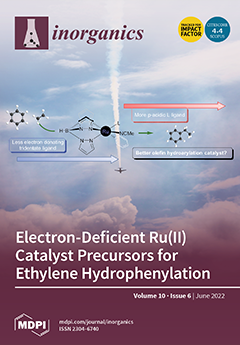As the overall turnover-limiting step (TOLS) in the homogeneous conversion of N
2O, the oxygen-atom transfer (OAT) from an N
2O to an Ru-H complex to generate an N
2 and Ru-OH complex has been comprehensively investigated by density functional theory
[...] Read more.
As the overall turnover-limiting step (TOLS) in the homogeneous conversion of N
2O, the oxygen-atom transfer (OAT) from an N
2O to an Ru-H complex to generate an N
2 and Ru-OH complex has been comprehensively investigated by density functional theory (DFT) computations. Theoretical results show that the proton transfer from Ru-H to the terminal N of endo N
2O is most favorable pathway, and the generation of N
2 via OAT is accomplished by a three-step mechanism [N
2O-insertion into the Ru-H bond (TS-1-2, 24.1 kcal mol
−1), change of geometry of the formed (Z)-O-bound oxyldiazene intermediate (TS-2-3, 5.5 kcal mol
−1), and generation of N
2 from the proton transfer (TS-3-4, 26.6 kcal mol
−1)]. The Gibbs free energy of activation (ΔG
‡) of 29.0 kcal mol
−1 for the overall turnover-limiting step (TOLS) is determined. With the participation of potentially existing traces of water in the THF solvent serving as a proton shuttle, the Gibbs free energy of activation in the generation of N
2 (TS-3-4-OH
2) decreases to 15.1 kcal mol
−1 from 26.6 kcal mol
−1 (TS-3-4). To explore the structure–activity relationship in the conversion of N
2O to N
2, the catalytic activities of a series of Ru-H complexes (C1–C10) are investigated. The excellent linear relationships (R
2 > 0.91) between the computed hydricities (ΔG
H−) and ΔG
‡ of TS-3-4, between the computed hydricities (ΔG
H−) and the ΔG
‡ of TOLS, were obtained. The utilization of hydricity as a potential parameter to predict the activity is consistent with other reports, and the current results suggest a more electron-donating ligand could lead to a more active Ru-H catalyst.
Full article





